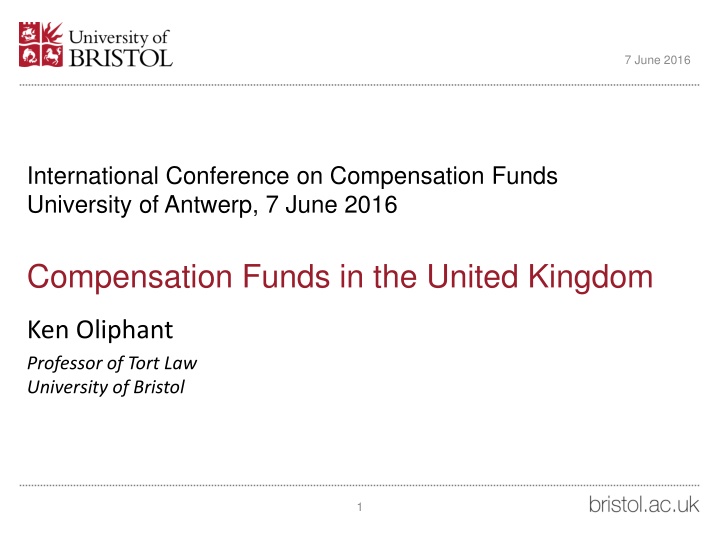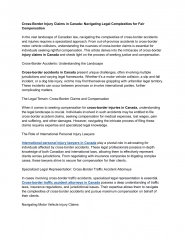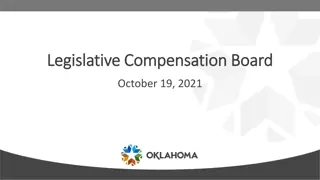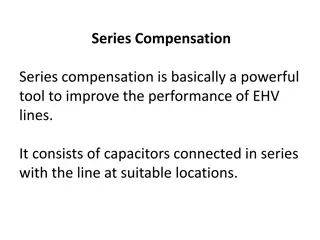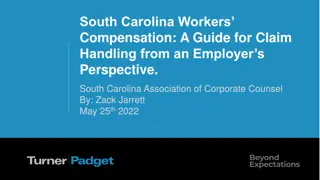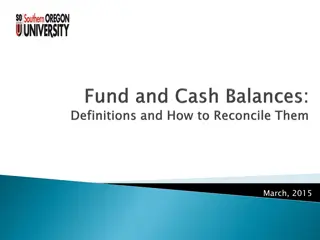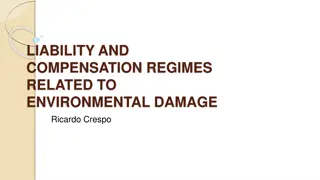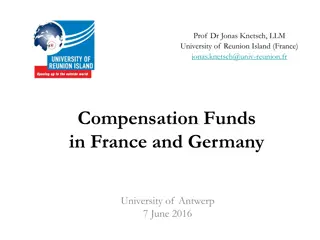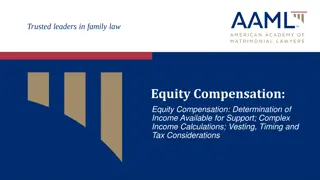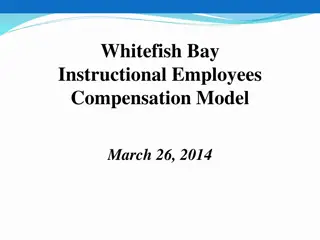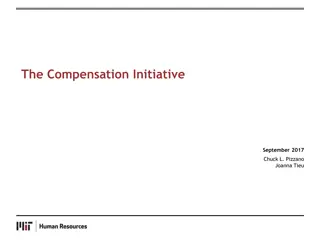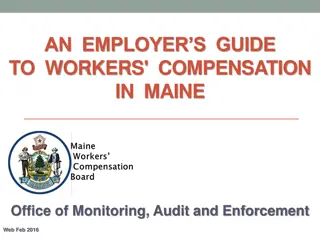Compensation Funds in the United Kingdom
Evolution and significance of compensation funds in the UK with a detailed chronology of developments, social security context, and the definition of a compensation fund. Uncover the unique role played by these funds in the broader compensation landscape and their distinction from private insurance and social security schemes.
Download Presentation

Please find below an Image/Link to download the presentation.
The content on the website is provided AS IS for your information and personal use only. It may not be sold, licensed, or shared on other websites without obtaining consent from the author.If you encounter any issues during the download, it is possible that the publisher has removed the file from their server.
You are allowed to download the files provided on this website for personal or commercial use, subject to the condition that they are used lawfully. All files are the property of their respective owners.
The content on the website is provided AS IS for your information and personal use only. It may not be sold, licensed, or shared on other websites without obtaining consent from the author.
E N D
Presentation Transcript
7 June 2016 International Conference on Compensation Funds University of Antwerp, 7 June 2016 Compensation Funds in the United Kingdom Ken Oliphant Professor of Tort Law University of Bristol 1
7 June 2016 Introduction Compensation in the UK comes from a number of different sources Social security Private insurance Tort law A surprisingly wide variety of other compensation funds and schemes Aim for today: to identify the role played in the overall system by the compensation funds But first: some history and some context Compensation Funds Conference, Antwerp 2
7 June 2016 Compensation: chronology of developments 1714 Riot damage (cf Act of 2016) 1897 Workmen s compensation 1930 Compulsory motor insurance 1946 Creation of Motor Insurers Bureau (compensation for victims of uninsured drivers) 1948 Creation of welfare state / Abolition of workmen s compensation 1964 Criminal Injuries Compensation 1979 Vaccine damage payments / 1st asbestos scheme 1988 Contaminated blood Compensation Funds Conference, Antwerp 3
7 June 2016 Context Social security Universal, non-contributory cover on the Beveridge model Social insurance plays a limited role Workers compensation (est 1897) was absorbed into social security on creation of the welfare state (1948) Tort A predominantly fault-based system Little strict liability (not even road accidents) Auto no-fault not implemented in UK State / public authority liability of limited scope Generally no liability for supervisory failures No principle of galit devant les charges publiques Compensation Funds Conference, Antwerp 4
7 June 2016 What is a compensation fund? Not a legal term of art nor a term in common use cf more usual reference to compensation schemes Overlap with idea of no-fault compensation But compensation may be for injury caused by someone s fault Compensation may be intended to head off a civil claim for damages based on fault on the part of the State Compensation schemes need not make use of a specific fund cf workmen s compensation (1897 1948), based on private insurance Thesis: a compensation fund is a compensation scheme that manages its own finances and is distinct from private insurance and social security Compensation Funds Conference, Antwerp 5
7 June 2016 Overview of compensation funds in the UK Asbestos-related disease Healthcare provision (vaccines and blood) Motor vehicle accidents (uninsured and untraced drivers) Criminal injuries Financial services Agriculture Compensation Funds Conference, Antwerp 6
7 June 2016 Compensation for asbestos-related disease Social security (industrial disablement benefit) Tort law (employers liability/EL claims) Three separate compensation funds 1979 scheme (pneumoconiosis and other dust-related disease) 2008 mesothelioma scheme (non-occupational exposure) 2014 diffuse mesothelioma payment scheme (employees with tort claims but unable to pursue them) (FSCS?) Dedicated trust funds (for T&N claimants) Compensation Funds Conference, Antwerp 7
7 June 2016 1979 Pneumoconiosis Compensation Scheme Pneumoconiosis etc (Workers Compensation) Act 1979 For sufferers of specified dust related industrial diseases, including Asbestosis (a form of pneumoconiosis) Diffuse mesothelioma Pleural plaques Lung cancer (if accompanied by asbestosis or pleural plaques) Lump sum payments A top-up to Industrial Injuries Disablement Benefit Weekly amounts of 33.60 - 168 Max rate paid for diffuse mesothelioma and lung cancer Compensation Funds Conference, Antwerp 8
7 June 2016 2008 Mesothelioma Compensation Scheme Child Maintenance and Other Payments Act 2008, Part 4 For non-employment related exposure Exposure from a relative (egfrom their overalls) Environmental (eg living near a factory using asbestos) Self-employed Unable to trace specific exposure to asbestos Funded out of compensation recoveries Lump sum payments, varying from 13,295 (for those aged 77 or over at the date of diagnosis), to 53,173 (for those aged 37 or under) Compensation Funds Conference, Antwerp 9
7 June 2016 2014 Diffuse Mesothelioma Payment Scheme Mesothelioma Act 2014 For those negligently exposed to asbestos in employment but unable to recover compensation in practice Time lapse means no solvent employer remains to be sued Employee often unable to trace EL insurer Funded by a levy on insurance companies currently active in the EL insurance market on a (current) market-share basis Lump sum payments, varying from 87,061 (for those aged 90 and over at the time of diagnosis), to 271,120 (for those aged 40 and under) Compensation Funds Conference, Antwerp 10
7 June 2016 Financial Services Compensation Scheme Relief of employers where they cannot enforce their contribution rights in mesothelioma cases Employers claim for contribution from other responsible persons to be paid out of the compensation fund which guarantees payments in the event of an insurer s insolvency if it appears that the other responsible persons are insolvent Quid quo pro for joint and several liability imposed on employers in mesothelioma cases: Compensation Act 2006 Cf Barker v Corus (UK) plc(2006): insolvent employers responsible for 83% of total asbestos exposure Cf Sienkiewicz v Greif (UK) Ltd (2011): defendant responsible for only 15% of exposure; 85% was environmental exposure Compensation Funds Conference, Antwerp 11
7 June 2016 Compensation relating to healthcare provision Vaccine damage Vaccine Damage Payments Act 1979 Rationale: vaccine injury is the very occasional price that society pays for the benefit of defeating disease through national vaccination programmes A fixed sum of 120,000 Limited to cases of severe (ie 60% or greater) disablement resulting from vaccination against specified diseases Infection with Hepatitis C or HIV by NHS blood Charitable trusts and not-for-profit companies established & funded by government Payment on ex gratia basis To date: over 390 million has been paid (since 1988) Compensation Funds Conference, Antwerp 12
7 June 2016 Infection with Hep C or HIV from blood products HIV: two charitable trust funds established & funded by government Macfarlane Trust, est 1987 (haemophiliacs infected with HIV as a result of contaminated NHS blood products) (plus MFET Ltd, est 2010) Eileen Trust, est 1993 (non- haemophiliacs infected with HIV through blood transfusion or tissue transfer) Lump sums of 20,000 and up to 80,500; annual payment of 14,749; discretionary bereavement payments for dependants on low incomes Hepatitis C: Skipton Fund, a company est 2004 (infection with Hep C through treatment with NHS blood/blood products prior to Sept 1991) Lump sums of 20,000 plus (severe cases) 25,000; no annual payments until 2011 (now 14,749); no support to dependants Caxton Foundation, est 2011, following review highlighting disparities (providing further, targeted support for Skipton Fund beneficiaries and their dependants) Compensation Funds Conference, Antwerp 13
7 June 2016 Review of Hep C/HIV compensation Discrepancies in compensation as between Hep C and HIV sufferers identified in 2010 review, leading to creation of Caxton Fund Further review 2016: Dept of Health, Infected blood: reform of financial and other support Criticised outdated and confusing funding structure, differences in payments and policies, lack of individualised assessment of beneficiaries Proposes a unified scheme run by a single body Flat-rate annual payments to be replaced by different payment levels assigned following individualised assessment Opposed by victims groups, who fear that most will be left worse off financially and in a position of uncertainty Compensation Funds Conference, Antwerp 14
18 February 2025 Reform of compensation for medical injuries? Kennedy Report, 2001 recommended abolition of law of clinical negligence and replacement with no-fault compensation to encourage open reporting of adverse events and near misses Chief Medical Officer report of 2003 (Making Amends) considered a general no-fault scheme for medical injuries would be too expensive, but recommended a (much) narrower scheme for birth injuries resulting in severe neurological impairment Suggestion not taken up by Government Narrower NHS Redress scheme enacted but not yet implemented (except in Wales) More a mechanism for settling low-to-medium value tort claims than a distinct compensation scheme 15
7 June 2016 Motor Insurers Bureau Established by insurance industry in 1946 in response to Ministry of Transport pressure Cynics suggest it was designed to forestall legislative intervention Insurers to contribute, pro rata to the amount of their motor business, to a fund from which compensation would be paid to victims of uninsured drivers Compensation extended to victims of untraced drivers in 1968 In 2011, the MIB settled 55,222 claims and paid compensation totalling 251.5 million Compensation Funds Conference, Antwerp 16
7 June 2016 An employers liability insurance bureau (ELIB)? Should there be an equivalent to the MIB in the context of compulsory employers liability (EL) insurance? Strongly urged by unions and other groups Rejected consistently by government 2012: running costs would be disproportionate to benefits The unique case of mesothelioma recognised, leading to creation of Diffuse Mesothelioma Payment Scheme 2014 (above) Compensation Funds Conference, Antwerp 17
7 June 2016 Criminal Injuries Compensation Compensation for personal injury which is directly attributable to being a direct victim of a crime of violence Established 1964 Initially non-statutory Payments on an ex gratia basis Placed on statutory basis in 1988. See now Criminal Injuries Compensation Act 1995 Rationale was sympathy for the innocent victim of crime Rejection of view that the compensation discharged a liability ofthe State Fund financed from general taxation, finances allocated by Ministry of Justice Meets obligation imposed by Directive 2004/80/EC relating to compensation to crime victims Compensation Funds Conference, Antwerp 18
7 June 2016 Criminal Injuries Compensation (cont) Compensation initially awarded at full level of damages in tort Statutory tariff introduced 1996 Awards not based on the personalised assessment Maximum award: 500,000. Calls for more extensive compensation entitlements for victims of terrorism after 7/7 bombings in London in 2005 rejected Government reiterated that CIC is akin to charity rather than discharging a liability But compensation extended to victims of (specified) overseas terrorism in 2012 eg Brussels airport (March 2016), Paris (November 2015) Compensation Funds Conference, Antwerp 19
7 June 2016 Compensation funds in the financial sector Financial Services Compensation Scheme A scheme of last resort for customers of financial services that fail (eg stop trading and default on claims) Aim to preserve consumer confidence in the financial services sector FSCS has protected more than 4.5m consumers since 2001 and paid out more than 26bn in compensation In 2015/16, FSCS paid out 272m in compensation to consumers as a result of 32,000 claims Pensions Protection Scheme For those whose pension funds fail or who are the victims of frahd Compensation Funds Conference, Antwerp 20
7 June 2016 Agriculture Animal Health Act 1981 Slaughter of animals affected with foot and mouth disease or another specified disease Farmers to be paid compensation in the value of the animal Compensation also for infected material such as straw destroyed during a cull Aim: to encourage participation in slaughter programmes to protect agricultural business in general, to relieve those who pay the price in the general benefit Foot & Mouth outbreak, 2001:payments of 1,158 million for slaughter of 4.2 million animals Voluntary Livestock Welfare (Disposal) Scheme 2001 Introduced in 2001 Outbreak of Foot and Mouth Disease for animals who were not directly affected by FMD but could not be moved to alternative pasture or sent to market Payment of 205 million for the slaughter of two million animals Compensation Funds Conference, Antwerp 21
7 June 2016 Evaluation Funds guaranteeing tort compensation rights Motor Insurance Bureau (uninsured and untraced driver claims) 2014 Diffuse Mesothelioma Payment Scheme But rejection of idea of ELIB Funds based on state responsibility Criminal injuries compensation Vaccination damage Hep c/HIV from infected blood Funds to protect general business interests Financial services compensation and pensions protection Slaughter of diseased animals Funds based on social solidarity? Compensation Funds Conference, Antwerp 22
7 June 2016 General issues Full or partial compensation? Effect on compensation under general law? A Superfund? Cf general no-fault accident scheme introduced for personal injury in New Zealand, 1974 Not adopted by Pearson Commission (UK), 1979 Little prospect of further developments at a general level in the UK Compensation Funds Conference, Antwerp 23
